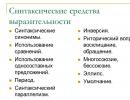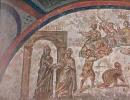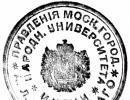Raising an algebraic fraction to a power." Lesson "Multiplication and division of algebraic fractions. Raising an algebraic fraction to a power" Multiplication of algebraic fractions with different denominators
We can perform multiplication and division of arithmetic fractions, for example:
if the letters a, b, c and d stand for arithmetic integers.
The question arises whether these equalities do not remain valid if a, b, c and d stand for: 1) some arithmetic numbers and 2) any relative numbers.
First of all, you will have to consider complex fractions, for example:


These examples are already enough to verify the validity of the equalities relating to the multiplication and division of fractions, when the numbers a, b, c and d are any (whole or fractional) arithmetic. Note that there are only 2 basic equalities, namely:

It remains now to consider whether these equalities remain valid if some of the numbers a, b, c and d are assumed to be negative: if, for example, a is a negative number, b, c and d are positive, then the fraction is negative and the fraction is positive; therefore, for example, dividing by should result in a negative number, but we see that, according to our assumption, the expression should also express a negative number, i.e., equality is justified in this case as well. It is also easy to consider other assumptions for the signs of a, b, c and d. The result of this consideration is the belief in the validity of the equalities
![]()
and for the case when a, b, c and d express any relative numbers, that is, for the multiplication and division of algebraic fractions, the same rules remain in force as for arithmetic ones.
Now we can perform multiplication and division of algebraic fractions. The greatest difficulty here is the question of the reduction of fractions obtained after multiplication or division. If the algebraic fractions are one-term, then the reduction of the result obtained will not present any difficulties, and if the fractions are algebraic, then it is necessary to factorize the numerator and denominator of each of these fractions.


Topic: Multiplication and division of algebraic fractions
Education is what remains when everything learned has already been forgotten.
Laue
Goals:
Educational:
fix ZUN on the topic
conduct primary current control of knowledge
work on the gaps
Developing:
contribute to the development of communicative competence, i.e. the ability to work effectively with others.
promote the development of cooperative competence, i.e. ability to work in pairs.
contribute to the development of problem-solving competence, i.e. the ability to understand the inevitability of difficulties in the course of any activity.
Educational:
to instill the ability to adequately evaluate the work done by a friend;
when working in pairs, to cultivate the qualities of mutual assistance, support.
Methodical:
creating conditions for the manifestation of individuality, cognitive activity students;
show the methodology of the lesson with the design of the results learning activities and methods of their research on the basis of competence-based approach.
Equipment: board, colored chalk. Table "Multiplication and division of algebraic fractions"; cards for individual work, memory cards. Free minute assignment.
During the classes
Organizing time
The lesson plan is written on the board:
Oral workout.
Individual work.
Problem solving.
Pair work.
Summary of the lesson.
Homework.
Teacher: In the old days in Rus' it was believed that if a person was versed in mathematics, then this meant the highest degree learning. And the ability to see and hear correctly is the first step to wisdom. I want all the students in your class today to show how wise they are and how well-versed people are in algebra of the 7th grade.
So, the topic of the lesson is "Multiplication and division of algebraic fractions" In the last lesson, you started studying this topic, and we discussed why we are studying it. Let's remember where it will come in handy in a few lessons.
Students: For joint actions with algebraic fractions, for solving equations, and hence problems.
Teacher: Even in the old days in Rus' they said that multiplication is torment, and division is trouble. Anyone who could quickly and accurately multiply and divide was considered a great mathematician.
What goals will you set for yourself?
Students: Continue to study the topic, learn to quickly and accurately multiply and divide.
Teacher: To achieve our goals, we (opens the plan written on the board, pronounces it)
1. Oral warm-up: (during this time 3 - 4 people solve the simulator for reducing fractions in pairs) factorize by filling in the gaps
1= (y-1) (...), 5a+5b=... (a+b), xy-x=x (...), 14-2x=...
reduce the fraction
Fractions, fractions, fractions beat cut them do not spare.
find the mistake made when multiplying and dividing algebraic fractions
Teacher: Where is the error? Why is the error made? What rule did the student not know? What did you know? How to do it right?
2. Work in a notebook, № from the textbook 488 (1) Analysis, solution, verification.
Teacher: And now you will have the opportunity to show your knowledge when taking the test, and to inspire you to work, I will read the rhyme "So that the teacher writes" 5 "in your diary, manage to multiply the numerator by the numerator in an instant, and so that the teacher is pleased with you, you will multiply the first denominator by the second "
Self-check, mutual check. According to the criteria (posted on the board) B-1 (321), B-2 (132) according to the correct codes, assessment in pairs. initial result. Estimates.
Work on mistakes in pairs "student-teacher"
If there are no mistakes in pairs, they do the task in a free minute.
Simplify the expression and find its value when
5. Summary of the lesson
In conclusion of the lesson, I would like to ask you what types of work caused you difficulties? Why do you think? What did you learn new? Which of you is satisfied with your work in the classroom? Do you think the goals set at the beginning of the lesson have been achieved?
Teacher: I would like to finish the lesson with the words of the French engineer-physicist Laue: "Education is what remains when everything learned has already been forgotten"
I hope that you will not forget this material, so that this does not happen, you must complete d / z No. 486,487,488 even.
Additional materials
Dear users, do not forget to leave your comments, feedback, suggestions. All materials are checked by an antivirus program.
Teaching aids and simulators in the online store "Integral" for grade 8
Algebra electronic workbook for grade 8
Multimedia textbook for grade 8 "Algebra in 10 minutes"
Preliminary factorization of an algebraic fraction
Before starting to work with fractions, namely multiplication and division, it is advisable to factorize the numerator and denominator into factors. This will make it easier to factorize the fraction that will result from the mathematical operation.For example, given a fraction:
$\frac(8x+8y)(16)$.
We perform an identical transformation, that is, we decompose the numerator into factors.
$\frac(8x+8y)(16)=\frac(8(x+y))(16)$.
Or, for example, given a fraction like this:
$\frac(x^2-y^2)(x+1)$.
It is better to bring it to this form:
$\frac(x^2-y^2)(x+1)=\frac((x+y)(x-y))(x+1)$.
Don't forget the property:
$(b-a)^2=(a-b)^2$.
Multiplication of algebraic fractions with the same and different denominators
Multiplication of algebraic fractions is done in the same way as multiplication ordinary fractions. The numerators and denominators are multiplied together.This can be represented as a formula as follows:
$\frac(a)(b)*\frac(c)(d)=\frac(ac)(bd)$
Let's look at a few examples.
Example 1
Calculate:
$\frac(5x+5y)(x-y)*\frac(x^2-y^2)(10x)$.
Let's factorize the fraction.
$\frac(5x+5y)(x-y)*\frac(x^2-y^2)(10x)=\frac(5(x+y))(x-y)*\frac((x-y)(x+ y))(10x)$.
Let's bring both fractions to a common denominator (remember the lesson: "Addition and subtraction of fractions", where there were tips on how best and easier to choose a common denominator). As a result, we get a fraction.
$\frac(5(x+y)(x-y)(x+y))((x-y)*10x)=\frac((x+y)^2)(2x)$
Example 2
Calculate:
$\frac(7a^3b^5)(3a-3b)*\frac(6b^2-12ab+6a^2)(49a^4b^5)$.
Let's factorize and reduce the fraction.
$\frac(7a^3b^5)(3a-3b)*\frac(6(b^2-2ab+a^2))(49a^4b^5)=\frac(7a^3b^5*6 (b-a)^2)(3(a-b)*49a^4b^5)=\frac(2(b-a)^2)(7a(a-b))$.
Division of algebraic fractions with the same and different denominators
The division of fractions is carried out in the same way as the division of ordinary fractions, that is, you need to turn the "divisor" fraction and multiply.$\frac(a)(b):\frac(c)(d)=\frac(ad)(bc)$
Consider examples.
Example 3
Follow these steps:
$\frac(x^3-1)(8y):\frac(x^2+x+1)(16y^2)$.
Let's factorize fractions.
$\frac(x^3-1)(8y):\frac(x^2+x+1)(16y^2)=\frac((x-1)(x^2+x+1))( 8y):\frac(x^2+x+1)(16y^2)$.
Now flip the fraction and multiply.
$\frac((x-1)(x^2+x+1)*16y^2)(8y*(x^2+x+1))=2y*(x-1)$.
Example 4
Calculate:
$\frac(a^4-b^4)(ab+2b-3a-6):\frac(b-a)(a+2)$.
We factorize and group the polynomials.
$\frac(a^4-b^4)(ab+2b-3a-6):\frac(b-a)(a+2)=\frac((a^2-b^2)(a^2+ b^2))((ab+2b)-(3a+6)):\frac(b-a)(a+2)=$
$\frac((a-b)(a+b)(a^2+b^2))(b(a+2)-3(a+2)):\frac(b-a)(a+2)$.
Flip and multiply fractions.
$\frac((a-b)(a+b)(a^2+b^2)(a+2))((a+2)(b-3)(b-a))=\frac(-(a+ b)(a^2+b^2))((b-3))$.
In this lesson, we will consider the rules for multiplying and dividing algebraic fractions, as well as examples for applying these rules. Multiplication and division of algebraic fractions is no different from multiplication and division of ordinary fractions. However, the presence of variables leads to somewhat more complex ways of simplifying the resulting expressions. Despite the fact that multiplying and dividing fractions is easier than adding and subtracting them, the study of this topic must be approached very responsibly, since there are many "pitfalls" in it that are usually not paid attention to. As part of the lesson, we will not only study the rules for multiplying and dividing fractions, but also analyze the nuances that may arise when applying them.
Subject:Algebraic fractions. Arithmetic operations on algebraic fractions
Lesson:Multiplication and division of algebraic fractions
The rules for multiplication and division of algebraic fractions are absolutely similar to the rules for multiplication and division of ordinary fractions. Recall them:
That is, in order to multiply fractions, it is necessary to multiply their numerators (this will be the numerator of the product), and multiply their denominators (this will be the denominator of the product).
Division by a fraction is multiplication by an inverted fraction, that is, in order to divide two fractions, it is necessary to multiply the first of them (the dividend) by the inverted second (the divisor).
Despite the simplicity of these rules, many people make mistakes in a number of special cases when solving examples on this topic. Let's take a closer look at these special cases:

In all these rules, we used the following fact: .
Let's solve some examples of multiplication and division of ordinary fractions in order to remember how to use the indicated rules.
Example 1
Note: when reducing fractions, we used the decomposition of a number into prime factors. Recall that prime numbers
are called such integers, which are divisible only by and by itself. The rest of the numbers are called constituent
. The number is neither prime nor composite. Examples prime numbers: ![]() .
.
Example 2
Let us now consider one of the special cases with ordinary fractions.
Example 3
As you can see, multiplying and dividing ordinary fractions, if the rules are applied correctly, is not difficult.
Consider multiplication and division of algebraic fractions.
Example 4
![]()
Example 5
![]()
Note that it is possible and even necessary to reduce fractions after multiplication according to the same rules that we previously considered in the lessons on the reduction of algebraic fractions. Consider a few simple examples for special cases.
Example 6
![]()
Example 7
![]()
Let's now look at a few more difficult examples for multiplication and division of fractions.
Example 8
![]()
Example 9
Example 10
Example 11
Example 12
Example 13
Before that, we considered fractions in which both the numerator and denominator were monomials. However, in some cases it is necessary to multiply or divide fractions whose numerators and denominators are polynomials. In this case, the rules remain the same, and for reduction it is necessary to use the formulas of abbreviated multiplication and parentheses.
Example 14
Example 15
Example 16
Example 17
Example 18






